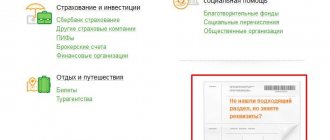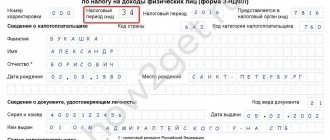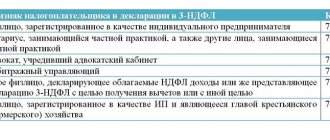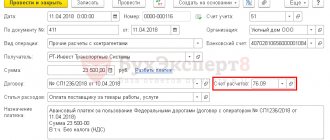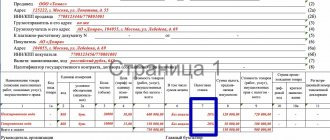Importing goods from foreign countries is associated not only with settlements with a foreign supplier, but also with settlements with customs. When processing import transactions, many questions may arise.
Let's look at how in 1C 8.3 Accounting:
- capitalize imported goods;
- fill out the customs declaration for import .
For more details, see the online course: “Accounting and tax accounting in 1C: Accounting 8th ed. 3 from A to Z"
Step-by-step instruction
The organization entered into a contract with the supplier Galaxy LLC for the supply of goods from Germany in the amount of 20,000 EUR.
On March 11, an advance payment in the amount of 10,000 EUR was made.
On March 19, the supplier Galaxy LLC shipped the goods Lathe IM-1 (1 pc.) worth 20,000 EUR. The transfer of ownership of the goods occurs at the moment the goods are transferred by the carrier to the buyer’s warehouse. Delivery basis - DAP Moscow.
On March 27, advance customs payments were made (VAT - 315,000 rubles, duty - 75,000 rubles, fee - 750 rubles).
On March 29, customs declaration of goods was carried out. The machine was delivered to the warehouse and accepted for accounting.
Conditional courses for example design:
- March 11 — the rate of the Central Bank of the Russian Federation is 73.00 rubles/EUR;
- March 29 — the rate of the Central Bank of the Russian Federation is 75.00 rubles/EUR.
Transfer of an advance to a foreign supplier
List the advance payment using the document Write-off from the current account, transaction type Payment to supplier in the Bank and cash desk section – Bank – Bank statements.
Please indicate:
- Bank account - foreign currency bank account in EUR;
- VAT rate - Without VAT .
Postings
The customs declaration number is not indicated in the invoice: legal consequences
A Russian importer who has drawn up a customs declaration (cargo customs declaration, officially - DT or declaration for goods) for imported goods must, in the event of subsequent sale of the completed purchase, indicate in the invoice the number of the corresponding DT (subclause 14, clause 5, article 169 of the Tax Code of the Russian Federation) .
At the same time, if, during the resale of property, for some reason they did not indicate the customs declaration number on the invoice, then this cannot become a basis for refusing the subsequent receipt by the importer of a VAT deduction, when other information available in the tax documentation allows the Federal Tax Service to establish data about the supplier , the buyer, find out the names of goods, their price, VAT rates (Letter of the Ministry of Finance of Russia dated January 26, 2018 N 03-07-08/4259).
Please note that DT numbers are not recorded in invoices for goods imported from the EAEU, simply because customs declarations in such legal relations are generally not drawn up.
See here for details.
But how can an importer find the DT number if he decides to indicate it in tax documentation? How to record information about the customs declaration in the invoice?
Transfer of payment to customs
List the customs payment in the document Write-off from the current account type of transaction Other settlements with counterparties in the Bank and cash desk section - Bank - Bank statements.
The transfer of customs payments can be made in two payments: one for the payment of VAT and customs duties, the second for the payment of duties. This is due to the use of different BCCs when processing payments.
Read more Payment of VAT at customs when importing from third countries
But the overall filling will be the same:
- Agreement - basis for settlements, Type of agreement - Other ;
- Settlement account - 76.09 “Other settlements with various debtors and creditors.”
VAT and tax
Postings
Duty
Postings
Capitalization of imported goods in 1C 8.3
Receive goods from third countries using the document Receipt (act, invoice) transaction type Goods (invoice) in the section Purchases – Purchases – Receipt (acts, invoices).
Please indicate:
- Invoice No. from - data of the primary document, for example, invoice No. and date;
- from - date of transfer of ownership.
Fill out the table with the purchased goods.
- % VAT - Without VAT ;
See also How to correctly indicate the customs declaration and the country of origin of goods when importing
Postings
See also New “import” documents in the Federation Council (from the recording of the broadcast on December 21, 2021)
Customs declaration for import into 1C 8.3 Accounting
The customs declaration of goods is reflected in the import customs declaration document in the section Purchases - Purchases - import customs declaration. Create it based on the document Receipt (act, invoice) by clicking the Create based on .
Main tab :
- CCD number - number from column A of the customs declaration (CD);
- The deposit is the basis for settlements. Type of agreement - Other ;
- Customs duty - the amount of the fee, column 47 “Calculation of payments” by type of payment 1010;
- Link Currency - rub. Settlements with customs are carried out in rubles, so select rubles. After this, the data on the Sections of the Customs Declaration will be filled in in rubles;
- Calculations - the data on the link should be filled out if you need to offset the advance customs payment for specific payment orders. In our example, we do not select payments, since the payment was made according to two payment orders, and it is against them that the advance is credited automatically.
Mutual settlements with customs are carried out on account 76.09, therefore the Account for accounting of settlements with the counterparty is indicated exactly as such. The advance on it is counted in the same way as on accounts 60.02 or 62.02.
View Settlements with customs
- Reflect VAT deduction in the purchase book checkbox . If it is installed, then all payment documents against which the advance was offset will be reflected in the purchase book: payment orders for the payment of duties, fees, VAT. And it should only include the payment order that paid VAT.
BukhExpert8 recommends not checking this box, but registering a VAT deduction using the document Formation of purchase ledger entries , in which you can manually adjust the payment order data.
tab of the customs declaration based on the document Receipt (act, invoice) .
Please indicate at the top:
- Customs value : from column 12 “Total customs value” - if you fill out the entire declaration for goods;
- from column 45 “Customs value” - if you fill in according to the data in one of the sections of the declaration for goods.
In 1C, customs value is not stored or calculated.
- % duty - rate or fixed amount of duty on all goods (column 47 “Calculation of payments” of the declaration for goods, type of payment 2010). If the duty rate is not the same for goods, then the column is not filled in, and the total amount of duty is manually set in the Duty .
- % VAT - VAT rate for all goods (column 47 “Calculation of payments”, payment type 5010).
If, as a result of auto-filling the customs declaration document for imports, there are discrepancies in the amounts of duty and VAT, for example, due to rounding in 1C, then these amounts must be adjusted manually.
See also How the amount of VAT is calculated at customs when importing goods from non-CIS countries
Products by section:
- if there are several goods, then distribute the amounts of duty and VAT between the goods using the Distribute ;
- if duty is levied only on specific items, in the Duty , manually enter the amount of duty applicable to specific goods;
- Amount - the cost of goods from the document Receipt (act, invoice) , since it is this amount, together with the amounts of duty and fee, that is used to fill out column 15 of the purchase book (clause 6 of the Rules for maintaining the purchase book, approved by Decree of the Government of the Russian Federation dated December 26, 2011 N 1137).
- Accounting account, Accounting account (NU) - an accounting account in the debit of which duties and fees are reflected in the accounting system and NU;
- VAT account - account 19.05;
- Comment - BukhExpert8 advises filling out information about the payment slip for the payment of VAT offset against the customs declaration (column 47 “Calculation of payments”, type of payment 5010). This data will be needed when deducting VAT.
Postings
Purchase of imported goods in KA 2.4
The example was prepared on the demo base of the company 1C release 2.4.12.102
The ability to account for imported goods is determined by the functional option Master data and administration – Setting up Master data and sections – Accounting for VAT and foreign trade activities – Registration and control of customs declaration numbers – Trade in imported goods.
Figure 1 — Configuring customs declaration registration
Purchasing for import without filing a customs declaration
If the supply of imported goods does not require declaration, then it is formalized as a regular supply with the document Purchase of goods and services with the transaction type Purchase from a supplier or Acceptance for commission, indicating the customs declaration numbers and countries of origin in the tabular part of the document. For example, the supplier delivered imported goods that have already passed customs clearance. All expenses associated with the delivery of such cargo are recorded as additional expenses, which can be distributed among the cost of goods, line of business, other expenses, etc.
Import purchase with customs declaration
The possibility of registering the supply of imported goods with a customs declaration is determined by the functional option Master data and administration – Setting up master data and sections – VAT and foreign trade accounting – Import – Import purchases.
Figure 2 — Setting up trade in imported goods
Suppose an organization purchases from an import supplier. To do this, the agreement with the importing supplier must indicate the type of operation Import
.
Figure 3 — Import agreement with supplier
All other parameters of the agreement are filled out in the same way as for the regular supply of goods. Mutual settlements with the supplier-importer can be carried out in the context of contracts or without contracts. A separate contract is drawn up with the supplier-importer for the purchase of imported goods with the established type of relationship: Import.
Figure 4 — Import agreement with supplier
To supply imported goods, use the document Purchase of goods and services with the established type of operation Import. The document is drawn up in the same way as a regular receipt document.
Figure 5 - Purchase of goods and services
It is worth noting that until the customs declaration is completed, imported goods cannot be sold. These goods will be available for sale only after a customs declaration has been registered for them. After completing the customs declaration, the goods will be assigned a CCD number (country of origin) and will become available for sale.
Registration of customs declaration
You can complete a customs declaration from the Customs declarations for imports for clearance workspace (section Purchasing – Customs declaration for clearance).
Figure 6 — Customs declarations for imports for clearance
And you can also create it based on the Purchase of goods and services document.
Figure 7 - Customs declarations for imports based on
When you execute the Create Declaration command, a Customs Declaration document will be created, which will contain a list of goods that have not passed customs clearance, as well as information about the delivery document.
It should be noted that if the Separate import purchases by receipts flag is checked, then when posting a document, the correctness of filling out information on delivery documents will be monitored.
When preparing a customs declaration for import, customs declaration numbers are generated without adding a section number and product number.
Figure 8 — Filling out the customs declaration number
On the Customs Declaration Sections tab, data is filled in; if you need to supplement the Customs Declaration number with the product line number or section number, then for this opportunity, on the Civil Customs Declaration Sections tab in the tabular part of the Declaration Goods, the Serial No. field is provided. By default, the field is not filled in and is not required.
Figure 9 - Filling out the Serial No.
The values entered in the Serial No. field are saved in the CCD Numbers directory in the Product Serial Number attribute. You should also fill out all the information on the rate and duty amount and distribute it to the goods.
In the customs declaration, it is necessary to additionally fill in information about customs duties and fines, enter data on the customs value, duty and VAT of each section, distribute goods into sections, enter the cost of each product and distribute the total customs value among sections.
Figure 10 - Filling out calculations
Next is the document Customs declaration for import
can be carried out in two statuses:
At customs clearance
and
Released from customs
:
- The status at customs clearance
is preliminary.
When making a customs declaration in this status, information about the planned payment (to customs or broker) is recorded in the payment calendar. The planned payment date, type of payment, current account or cash register are filled in on the Additional
; - The status Released from customs
is established after the final processing of the customs declaration. When posting a document, an actual debt arises to customs (broker). The status of goods specified in the customs declaration changes from preliminary to the status of goods available for sale.
When posting a document in the status Released from customs
The cost of the goods specified in the declaration is automatically adjusted taking into account the calculated customs duty and the amount of VAT. No additional cost calculation is required. And also the goods arrive at the warehouse and are ready for sales.
Acceptance of VAT paid at customs for deduction
Accept VAT for deduction using the document Generating Purchase Ledger Entries in the Operations - Period Closing - Regular VAT Operations section.
Clicking the Fill will automatically display the data on accrued VAT at customs. But to correctly fill out the purchase book, make adjustments.
By default, the columns Doc. No. payment and date of doc. payments are hidden. If you are deducting VAT on imported goods, then make sure that these columns are filled out correctly: they should reflect the payment details for the payment of “import” VAT to the budget.
See also: How can an importer set up and complete this document?
VAT was paid by payment order No. 100 dated March 27, 2018 (column 47 “Calculation of payments”, payment type 5010).
This means that in order for the correct tax payment details to be indicated in the purchase book, make adjustments to the document by indicating the number and date of the payment order only for VAT - No. 100 dated 03/27/2018.
During the work process, the accountant may need to clarify and refill this document. To avoid having to repeat manual adjustments, create a separate document only to offset the VAT paid at customs. In the Comment , place a corresponding note, for example, Import .
Postings
How to reflect the payment of VAT when importing goods in 1C: Accounting 8?
Question:
The organization imports goods into Russia and pays VAT at customs. How can this be correctly reflected in “1C: Accounting 8” edition 3.0?
Answer:
Most often, export-import transactions are subject to value added tax. In order to correctly report VAT when importing imported goods, the taxpayer must correctly configure the program functionality. This is done in the Main section on the Inventory tab. Here you need to check the Imported goods checkbox.
The tax is calculated from the moment the money for the goods is transferred. Then, upon receipt of goods, the accountant, based on the act or invoice, registers this fact with the Receipt document. The operation type should be selected - Goods. In the document itself, in its tabular part, fill in the necessary fields with the price in the currency of the contract with the supplier, name, quantity, customs declaration number and country of origin of the imported product. It will be necessary to indicate accounting accounts. It is important that in the % VAT field you must indicate the value excluding VAT. This is done because the foreign supplier does not present the VAT amount. During customs clearance, both customs duties and import VAT are paid by the importer.
In the import customs declaration, which is located in the Purchases section, on the basis of acts and invoices, the amount of customs duties, the date and number of the customs declaration are entered. In the Deposit field you will need to enter the number of the agreement with customs, and in the Customs field - the name of the organization that prepared the documents. To account for settlements with customs, account 76.09 “Other settlements with various debtors and creditors” is selected.
In the future, the program itself will calculate the customs value of the goods and the amount of duty if a percentage is entered in the appropriate column. All payments will be made in the same currency as in the invoice on the basis of which the goods were accepted. And then the VAT amount will be automatically calculated. The program will take the course on the date of registration of the customs declaration. If the imported goods were supplied on an advance payment basis, the credited advance payment will need to be recalculated at the exchange rate at the time of the advance payment.
After VAT has been paid to the budget, part of the amount can be offset. To do this, you need to have documents confirming that the tax has been paid and the goods have been accepted for accounting.
The amount to be presented for deduction is calculated by the document Creating purchase ledger entries in the routine operations section. All data for the formation of this document will be reflected on the Acquired Assets tab.

